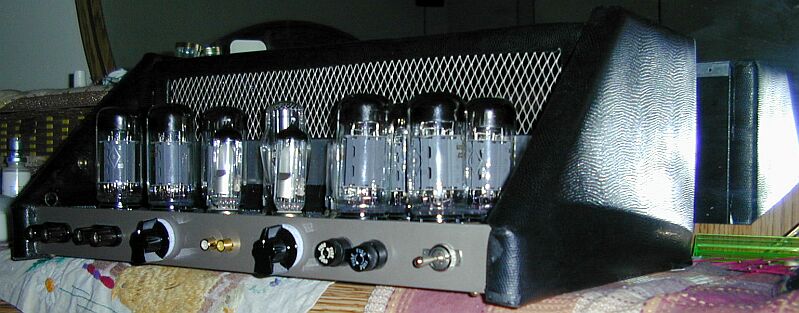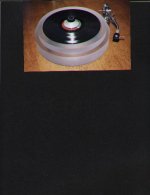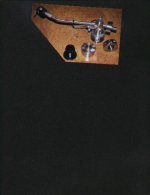Banned
Joined 2002
Re: Re: post 1273 ...
I'm renting the house, no other options available.
The corner absodber makes no harm; I had to dump windows and a closet door, and put some foam under the mask hanging on the wall. No rattles/colorations from the fireplace.
Anyway, I rent the house... "As is"
FastEddy said:The picture of your listening room.
Windbourn: Wondering your opinion on room treatments generally = it seems that that standup fireplace may not be the ideal corner absorber ... Yes/No?

I'm renting the house, no other options available.
The corner absodber makes no harm; I had to dump windows and a closet door, and put some foam under the mask hanging on the wall. No rattles/colorations from the fireplace.
Anyway, I rent the house... "As is"
I like it, good design... But what about heatsink? Is it enough for continuous full power?
audiomanics said:An externally hosted image should be here but it was not working when we last tested it.
Like this?
Or would you prefer to turn it around? (Yes, i know the aspect is wrong and the alignment too)
Howard movie
Kees
audiomanics said:More than enough! Class-D endstageBTW the whole frame is machined from 10mm aluminum toolingplate.
Kees
Oh mine lord, I did not know it is class D!

In such case you've bult it for military purposes!
I was thinking of class D powered directly without a power transformer, with hi-pot input transformer, for active speaker, of course! 170V for 2 Ohm load...
Wavebourn said:
I was thinking of class D powered directly without a power transformer, with hi-pot input transformer, for active speaker, of course! 170V for 2 Ohm load...
Wrong... This principle works like this: an 400KC signal is Amplitude Modulated, and amplified. At the end all HF is rejected with a coil.. Only the envelope is lead to the speakers.
This system has a very high efficiency of ~90% !! so even at full load only about 100W of heat is dissipated..
Kees
audiomanics said:
Wrong... This principle works like this: an 400KC signal is Amplitude Modulated, and amplified. At the end all HF is rejected with a coil.. Only the envelope is lead to the speakers.
This system has a very high efficiency of ~90% !! so even at full load only about 100W of heat is dissipated..
Kees
Hmmm... What is wrong? To eliminate power transformer becouse it is class D? I don't see any connections....
And is it really AMPLITUDE modulated, or pulse-wide?
audiomanics said:The amplitude is modulated by means of pulsewidth..
Maybe i got it wrong but here we have 230V Mains.. I have to transform that down to 85-0-85V to get a workable voltage for the amplifier.. Or do you mean something else??
Kees
We here have exactly 170 rectified.
Wavebourn said:We here have exactly 170 rectified.
Direct rectification of the mains in a linear supply is not recommended, it is dangerous. So much so, that, other than discussing how dangerous it is, it is a banned subject here.
dave
planet10 said:
Direct rectification of the mains in a linear supply is not recommended, it is dangerous. So much so, that, other than discussing how dangerous it is, it is a banned subject here.
dave
Oops... Sorry guys, I did not know it is banned! Indeed it is very dangerous, and not UL Listed!!!
WOWWavebourn said:One more, unfinished...

Sorry for the bad English but I'm from Bulgaria and i have don't speak english very well.
IGBT said:WOW
Perfect design!Can you post one image inside?
Sorry for the bad English but I'm from Bulgaria and i have don't speak english very well.
It's Ok. I'll post photos and schematics as soon as bring it back from the garage to finish.
Privet!
Anatoliy

my photo
Hello,
I have been browsing through all these photos. Some of them very nice and some a little insane. So i will post mine a platter ordered and made by the late Thomas Scheu 3 years ago. Still not in use but hope to finish it before the end of next year. The arm is a Fidelity Research 64S and the platter is designed for flywheel effect and use with a normal length arm. Couldn't find a 66S. Did ask a co worker to manufacture a replacement for the original arm base so now i have one in stainless steel like the arm itself and one that has a grip that makes the original one look a little funny. BUT one like the stainless steel would have raised the price considerably. It did take 3 hours to make one. 3 and a half to make two.
All this constucting takes to much time. Hardly have time to do the listening. Greetings Eduard
P.s. I think a good student at a vocational college can manufacture this kind of arm base with the cnc machinary available at school.
Hello,
I have been browsing through all these photos. Some of them very nice and some a little insane. So i will post mine a platter ordered and made by the late Thomas Scheu 3 years ago. Still not in use but hope to finish it before the end of next year. The arm is a Fidelity Research 64S and the platter is designed for flywheel effect and use with a normal length arm. Couldn't find a 66S. Did ask a co worker to manufacture a replacement for the original arm base so now i have one in stainless steel like the arm itself and one that has a grip that makes the original one look a little funny. BUT one like the stainless steel would have raised the price considerably. It did take 3 hours to make one. 3 and a half to make two.
All this constucting takes to much time. Hardly have time to do the listening. Greetings Eduard
P.s. I think a good student at a vocational college can manufacture this kind of arm base with the cnc machinary available at school.
Attachments
Re: #1270
8AL9, or 24JZ8. I tried both (8AL9 filament powered by rectified with Shottky bridge 6.3V; 24JZ8 connected in series to the 50V rail)
How does it drive? Easily.
Pentode is in triode mode loaded by a CCS, they are directly coupled (through a voltage shift shunted by a capacitor - I use bi-polar anode power), with a feedback from the 2'nd anode to the 1'st cathode with a current from the negative rail for compensation. Current on the 2'nd half of the tube is the maximal allowed by specs. Resistor in the 2'nd cathode is not needed, but I use it anyway bypassed by a big cap, to take a voltage from it for the relay logic that protects speakers (it presents when tubes are hot).
Class A follower is AC coupled by a capacitor, and it has own servo opamp on infrasounds. CCSs for FETs are made on BJTs. No global feedback from output of the follower. Triangles from 20 Hz to 20 KHz on a full swing are straight.
Also, I used couple of 6E1P indicators (analog of EM80) -- look cool in the darkness, like windows on the top of the tower are winking.
miklos said:Hi,
What is the triode/pentode TV tube used in your hair like class A construction and how does it driving the fets?
8AL9, or 24JZ8. I tried both (8AL9 filament powered by rectified with Shottky bridge 6.3V; 24JZ8 connected in series to the 50V rail)
How does it drive? Easily.
Pentode is in triode mode loaded by a CCS, they are directly coupled (through a voltage shift shunted by a capacitor - I use bi-polar anode power), with a feedback from the 2'nd anode to the 1'st cathode with a current from the negative rail for compensation. Current on the 2'nd half of the tube is the maximal allowed by specs. Resistor in the 2'nd cathode is not needed, but I use it anyway bypassed by a big cap, to take a voltage from it for the relay logic that protects speakers (it presents when tubes are hot).
Class A follower is AC coupled by a capacitor, and it has own servo opamp on infrasounds. CCSs for FETs are made on BJTs. No global feedback from output of the follower. Triangles from 20 Hz to 20 KHz on a full swing are straight.
Also, I used couple of 6E1P indicators (analog of EM80) -- look cool in the darkness, like windows on the top of the tower are winking.
An externally hosted image should be here but it was not working when we last tested it.
My simple low budget 4W SE, used soviet NOS tubes 6N9S and 6P13S.
Transformers are from old tube TV sets.
More pictures here http://www.foto24.ee/album/6272/1
- Home
- Amplifiers
- Tubes / Valves
- Photo Gallery

